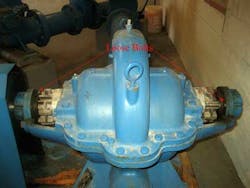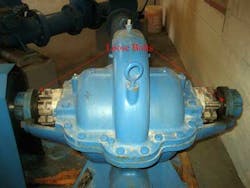Vibration Analysis Helps Identify Pump Problem
The water treatment facility in the City of Fairfield, Ohio, uses vibration analysis as part of its condition-monitoring planned/predictive maintenance program to help verify and assure equipment is operating satisfactorily. The Water Treatment Plant processes an average 5.1 mgd for a population of 44,000 people with a customer base of approximately 14,000 accounts.
Public Utilities Superintendent Andreas Eddy initiated the vibration analysis program as part of a cost savings measure with regard to "total" operating cost of equipment associated with the water treatment process. The intent was to identify potential equipment problems at an early stage and to allow maintenance work to be performed on a proactive basis.
Vibration data was collected with the Vixpert 2-channel vibration analyzer and plotted with Omnitrend software by Prueftechnik/Ludeca. The system helped identify a "Severe Mechanical Looseness" problem on a pump installed at a pumping station considered critical to the city's water system.
Initial baseline measurements of the unit revealed the mechanical looseness and a possible coupling problem with the pump and motor assembly. The vibration data showed severe impacting with high frequency harmonics characteristic of looseness of both pump bearings.
It was suspected that the looseness could be simply loose bolts on the bearing mounts and flanges, or a possible worst case scenario of internal looseness of the bearing components themselves.
The vibration analysis condition-monitoring survey report recommended that staff check all mounting and flange bolts of the bearing itself and to inspect the condition of the "steel grid" type motor-pump coupling.
The majority of the mounting bolts associated with the pump-bearing flange and pump supports were found to be very loose. Inspection of the motor-pump shaft coupling also revealed a lack of proper lubrication around the steel grid component. After corrective action, follow-up vibration measurements were taken to verify satisfactory results.
Ludeca is an exhibitor at the WEFTEC.12 event and can be found at Booth No. 6839
Editor's Note: Thanks to Ray W. Wonderly of Advanced Maintenance Technologies for sharing this case study. Special acknowledgement to Andreas Eddy, Superintendent of Water Treatment Operations, for co-authoring and approval of this case study.

